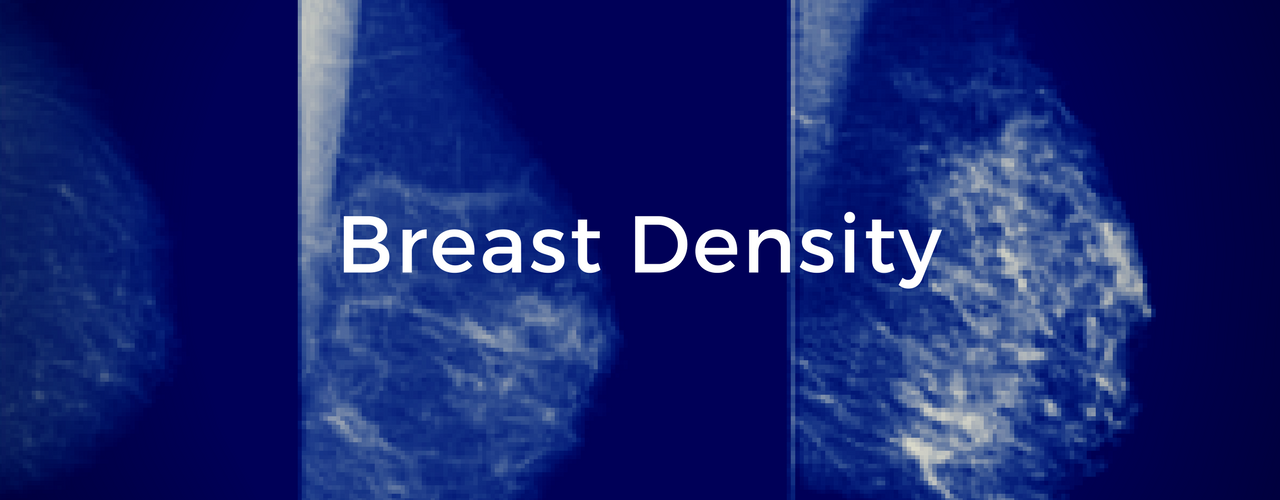Questions for your Physicians or Breast Surgeon:
- Do I have significantly dense breasts on my mammogram?
- Shouldn’t I have a 3D mammogram rather than a regular mammogram?
- What is my mammogram “BI-RADS density score?”
- Should I see a breast surgeon to discuss this?
What is mammographic breast density?
Breast density is a term used to describe how much breast tissue is made up of glands and supportive tissue. Dense breasts have more of this “thicker” tissue, which appears white on mammograms. Mammograms in women with very dense breasts can be more challenging to interpret by breast radiologists. Up to 40 percent of women have significantly dense breasts.
Why does breast density matter?
We have learned over time that women with dense breasts have a higher risk of developing breast cancer in their lifetime. Studies have yet to narrow down exactly how much of an increased risk, but the best “calculator” is the BCSC Calculator outlined in detail below.
Dense breasts also make it more difficult for radiologists to see a small breast cancer because these growths can be overshadowed by the dense or white appearing tissue on a mammogram.
So dense breasts pose a “double-whammy” of increased risk and decreased ability to find breast cancers on mammograms. The take-home message for those with dense breasts is to get regular mammograms, and ask for 3D mammograms if they are available to you. This best applies to those who have high BI-RADS Density scores of 3 and 4 (see below).
What is my “BI-RADS” Density Score on my mammogram report?
This scoring system is the radiologist’s estimate of breast density. The BI-RADS scores for low density are 1 and 2. High density are 3 and 4. The images below are examples of low to high density from left to right. The “terms” used to describe density in the figure below correspond to the BI-RADS scores 1 – 4.

LOWER DENSITY terms used on every mammogram report:
BI-RADS 1 or “A” or “Almost Entirely Fatty Tissue”
BI-RADS 2 or “B” or “Scattered Fibroglandular Tissue”
HIGHER DENSITY terms used on every mammogram report:
BI-RADS 3 or “C” or “Heterogeneously Dense”
BI-RADS 4 or “D” or “Extremely Dense”
Should I see a breast surgeon for density?
Seeing a breast surgeon is not generally necessary just for dense breasts. However, if you have multiple other “high risk” factors, or are at risk for carrying the BRCA mutation, ask for a breast surgeon consultation.
Calculate your risk for breast cancer
The new, online Breast Cancer Surveillance Consortium (BCSC) Risk Calculator (here) calculates your 5-year and 10-year risk of developing invasive breast cancer. It is the only “risk calculator” that includes breast density as a risk factor. It is designed for physicians, but you are free to use it also. We suggest you take a printout of “your calculated risk” to your physician to engage them in a discussion about your personal risk for developing breast cancer. Share this calculator with your physician in case they aren’t aware of this new tool.
Download the BCSC Risk Calculator iPhone App
![]()
To calculate your breast cancer risk online you will need a copy of your most recent mammogram report from your physician to complete the questions. Most radiologists will list a “BI-RADS” breast density score (1,2,3, or 4) or a description of the level of density as described above. Enter this “level” into the calculator in addition to the other information that is requested. The Breast Cancer Surveillance Consortium (BCSC) is a group of organizations that work together to advance breast cancer research.
Automated Whole Breast Ultrasound (ABUS)
Whole breast ultrasound was designed to screen women with dense breasts to improve the chance of finding a cancer that might be missed by mammography. It is not a replacement for mammograms. Mammograms are still essential to screen women with dense breasts. This type of ultrasound is designed to be used in addition to annual mammograms. When ABUS is added to mammographic screening, breast cancer detection can be improved by up to 50 percent.

The GE Healthcare Invenia ABUS system is the first FDA-approved device and is becoming more widely available in the community. Click (here) to find a facility near you that offers this ABUS service. More information about breast density and ABUS by GE Healthcare is located (here).
Patient-Friendly References:
This pdf printout (here) on “Breast Density and your Mammogram Report” is an excellent overview for patients about breast density. It is worth reading. The American Cancer Society is an organization that supports patients with cancer and funds research for cancer of all types.
Their website page (here) “Breast Density: What is it and what does it mean for me?” is a good overview of breast density for patients. This site is created for patients by the American Society of Breast Surgeons.
This page (here) “Breast Density Classification can be Unreliable” outlines the difficulty of “grading” breast density by radiologists and lets you know it is currently an imperfect science. This non-profit organization provides excellent patient resources about breast cancer.
Excellent educational resources are available (here) about breast density. “Are You Dense” is a non-profit organization dedicated to educating the public about the risks and screening challenges of dense breast tissue and its impact on missed, delayed and advanced stage breast cancer to reduce advanced disease and mortality.
More Detailed References:
If you want to get deep into the details about breast screening, this free pdf 70 page document (here) It lists guidelines to help clinicians appropriately screen women for breast cancer. You can easily register (here) as a non-professional to get access to more information about breast cancer.



